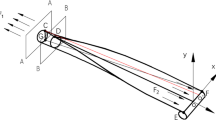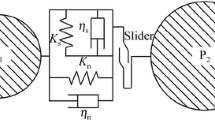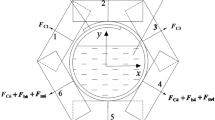Abstract
In order to increase the transport volume of the pipe belt conveyor and reduce lateral pressure of the supporting roller set, this study aims to optimize the pipe diameter of the pipe belt conveyor. A mechanical model of the pipe belt conveyor with six supporting roller sets in the belt bearing section was built based on the infinitesimal method, and the formula for calculating the lateral pressure of each supporting roller was deduced on the basis of reasonable assumption. Simulated analysis was carried out on the operation process of the pipe belt conveyor by using the discrete element method. The result showed that, when the other conditions were certain, as the pipe diameter increased, the average lateral pressure of the supporting roller set increased, with a gradually decreasing increment, which was consistent with the calculated result of the theoretical formula. An optimized pipe diameter under the current conditions was obtained by fitting the curve of the formula for calculating the transport volume of the pipe belt conveyor and its simulation curve. It provided a certain reference value for improving the transport efficiency and prolonging the service life of the pipe belt conveyor.










Similar content being viewed by others
References
Zamiralova Maria, E., & Gabriel, L. (2014). Pipe conveyor test rigs: Design, application and test results-Part A. Bulk Solids Handling, 5, 40–45.
Yijun, Z. (2013). Extended reach: Overland pipe conveyor with low rolling resistance belt. Bulk Solids Handling, 4, 16–21.
Maton, A. E. (2001). Tubular pipe conveyor design: A review of cross section and belt selection. Bulk Solids Handling, 2, 179–182.
Javad, A., Abdul, H., Abdul, R., et al. (2013). Design procedure of ultrasonic tomography system with steel pipe conveyor. Sensors and Actuators, A: Physical, 203, 215–224.
Vieroslav, M., & Gabriel, F. (2014). Contact forces in hexagonal idler housing of pipe conveyor. Bulk Solids Handling, 2, 52–56.
Vieroslav, M., Gabriel, F., & Beáta, S. (2014). Regression model design for the prediction of pipe conveyor belt contact forces on idler rollers by experimental tests. Applied Mechanics and Materials, 611, 265–272.
Vieroslav, M., Gabriel, F., & Beáta, S. (2014). Mathematical models for indirect measurement of contact forces in hexagonal idler housing of pipe conveyor. Measurement: Journal of the International Measurement Confederation, 1, 794–803.
Wang, Y., Du, Q., & Han, G. (2003). Environmental protection continual conveyor-pipe beit conveyor. Journal of Mechanical Engineering, 1, 149–158.
Wang, Y., & Du, Q. (2003). The development of special belt conveyor. Lifting Transportation Machinery, 9, 1–4.
del Coz D´ıaz, J. J., & Garc’ıa Nieto, P. J. (2007). Non-linear analysis and warping of tubular pipe conveyors by the finite element method. Mathematical and Computer Modelling, 2, 95–108.
Cordero, M. J., & Pugnaloni, L. A. (2015). Dynamic transition in conveyor belt driven granular flow. Powder Technology, 272, 290–294.
De-Song, B., Xun-Sheng, Z., Guang-Lei, X., et al. (2003). Critical phenomenon of granular flow on a conveyor belt. Physical Review E, 67, 1–3.
Pang, Y., & Lodewijks, G. (2013). Pipe belt conveyor statics: Comparison of simulation results and measurements. Bulk Solids Handling, 2, 52–56.
Zhang Y, Steven R. (2012). Pipe conveyor and belt: Belt construction, low rolling resistance and dynamic analysis. 2012 SME Annual Meeting and Exhibit, (pp. 616–619). Seattle, WA: Marcel Dekker.
Guo, Y., & Zhang, A. (1995). The determination of tubular belt conveyor transition section length. Mining Machinery, 2, 27–28.
Li, H., Li, Y., Tang, Z., et al. (2011). Numerical simulation and analysis of vibration screening based on EDEM. Transactions of the CSAE, 5, 117–121.
Wang, J., He, Y., & Sun, H. (2011). Discrete element numerical simulation for determining the influences of granular materials on dynamic response of silo structure. Journal of Henan University of Technology (Natural Science Edition), 2, 74–77.
Song, W., Chen, H., & Li, Q. (2013). Simulation of handling impact load of bulk material by DEM method. Journal of Northeastern University (Natural Science), 11, 1631–1634.
Cheng C. (2006). Research on distribution of lateral bulk-solid pressures on silos’ wall. HeFei University of Technology (Ph.D. Dissertation), pp. 25–26.
Zhang, Y. (2006). New type belt conveyor design manual. Beijing: Chemical Industry Press.
Acknowledgments
This research work was supported by the Emergency Management of National Natural Science Fund Project (Grant No. 41512002), the First-Class General Financial Grant from the China Postdoctoral Science Foundation (Grant No. 2013M540506) and Doctoral Fund of Ministry of Education of China (Grant No. 20133415110003).
Author information
Authors and Affiliations
Corresponding author
Rights and permissions
About this article
Cite this article
Guo, Yc., Wang, S., Hu, K. et al. Optimizing the Pipe Diameter of the Pipe Belt Conveyor Based on Discrete Element Method. 3D Res 7, 5 (2016). https://doi.org/10.1007/s13319-016-0085-8
Received:
Revised:
Accepted:
Published:
DOI: https://doi.org/10.1007/s13319-016-0085-8




